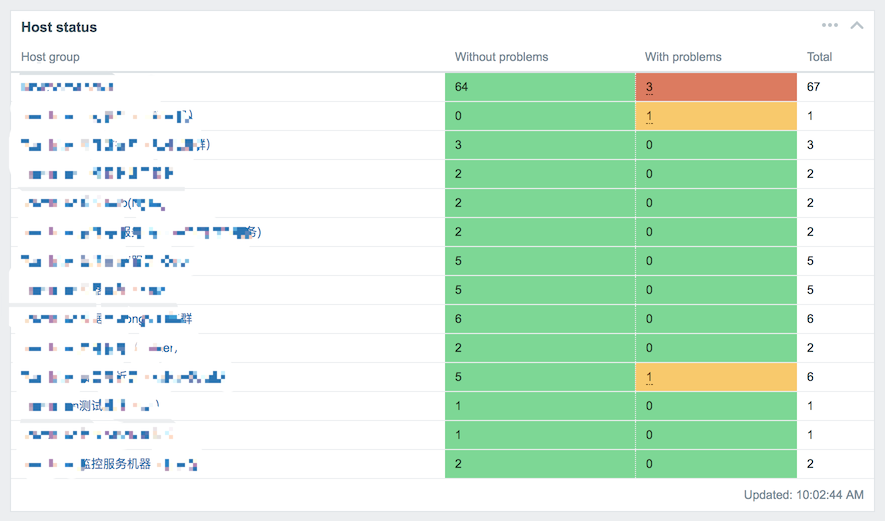获取 zabbix 挂件数据(widget)
Posted January 03, 2018
Zabbix 有非常丰富的 API ,但没有 widget 的 API。 所以获取 widget 的数据需要通过模拟登录爬取网页的形式来做。虽然我们可以用一定的 API 数据和相应的逻辑计算出此 TABLE 的数据, 但工作量非常大。

我用了两个模块来做, 一个逻辑控制 一个解析模块.
main.py
# -*- coding: utf-8 -*-
import sys
import json
import requests
from parse import HTMLTableParser
reload(sys)
sys.setdefaultencoding("utf-8")
HOST = "http://{{ HOST }}:8080/"
def parse(html):
p = HTMLTableParser()
p.feed(html)
table = p.tables[0]
c = [ {'prop': str(x), 'label': y} \
for x,y in zip(range(len(table[0])), table[0]) ]
return { "columns": c }, table[1:]
def login_session():
s = requests.Session()
payload = {
"name": "{{ USER }}",
"password": "{{ PASSWORD }}",
"autologin": "1",
"enter": "Sign in"
}
s = requests.Session()
resp = s.post(HOST + 'index.php', payload)
return s
def action(action_name):
session = login_session()
# 可以通过浏览器的开发者模式获取这里的参数, 一般需要更改 sid.
params = {
"action": action_name,
"sid": "8c09585cdef21c27", {{ SID }}
"upd_counter": 0,
"pmasterid": "dashboard"
}
payload = {"widgetRefresh": "syssum", '_': ""}
resp = session.post(
HOST + 'zabbix.php', params=params, data=payload)
data = json.loads(resp.text)
return data
def usage():
raise Exception(
"""Arg error, Missing key
Key choice in:
\twidget.status.view
\twidget.hosts.view
\twidget.system.view
\twidget.web.view
\twidget.issues.view"""
)
if __name__ == '__main__':
if len(sys.argv) != 2:
usage()
data = action(sys.argv[1])
config, data = parse(data["body"])
sys.stdout.write(json.dumps(config, indent=2)+'\n')
sys.stdout.write(json.dumps(data, indent=2)+'\n')
parse.py
from HTMLParser import HTMLParser
class HTMLTableParser(HTMLParser):
""" This class serves as a html table parser. It is able to parse multiple
tables which you feed in. You can access the result per .tables field.
"""
def __init__(
self,
decode_html_entities=False,
data_separator=' ',
):
HTMLParser.__init__(self)
self._parse_html_entities = decode_html_entities
self._data_separator = data_separator
self._in_td = False
self._in_th = False
self._in_span = 0
self._current_table = []
self._current_row = []
self._current_cell = []
self.tables = []
def handle_starttag(self, tag, attrs):
""" We need to remember the opening point for the content of interest.
The other tags (<table>, <tr>) are only handled at the closing point.
"""
if tag == 'span':
self._in_span = self._in_span + 1
if tag == 'td':
self._in_td = True
if tag == 'th':
self._in_th = True
def handle_data(self, data):
""" This is where we save content to a cell """
if self._in_td or self._in_th:
if self._in_span in (0, 1):
self._current_cell.append(data.strip())
else:
return
def handle_charref(self, name):
""" Handle HTML encoded characters """
if self._parse_html_entities:
self.handle_data(self.unescape('&#{};'.format(name)))
def handle_endtag(self, tag):
""" Here we exit the tags. If the closing tag is </tr>, we know that we
can save our currently parsed cells to the current table as a row and
prepare for a new row. If the closing tag is </table>, we save the
current table and prepare for a new one.
"""
if tag == 'td':
self._in_td = False
elif tag == 'th':
self._in_th = False
elif tag == 'span':
self._in_span = self._in_span - 1
if self._in_span < 2:
if tag in ['td', 'th']:
final_cell = self._data_separator.join(self._current_cell).strip()
self._current_row.append(final_cell)
self._current_cell = []
elif tag == 'tr':
self._current_table.append(self._current_row)
self._current_row = []
elif tag == 'table':
self.tables.append(self._current_table)
self._current_table = []
